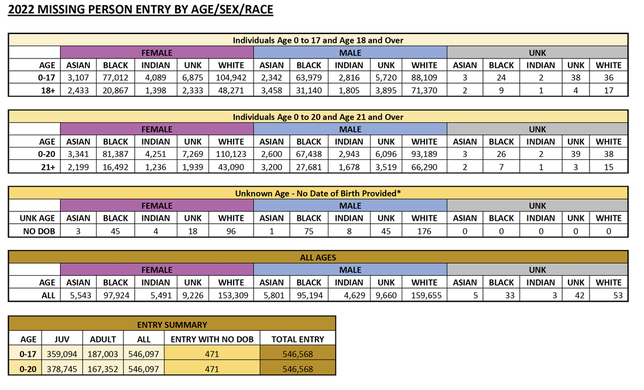When it comes to the number of missing Latinos in the U.S., the data doesn't tell the whole story10/24/2023 Over the last few years, public outcry has drawn national attention to the plight of missing Black people in the U.S. and the lack of media attention to those cases. According to data from the FBI's National Crime Information Center (NCIC), Black people are disproportionately represented among missing persons. The latest Census shows that Blacks make up roughly 13 percent of the U.S. population but represent a staggering 35 percent of the people reported missing in 2022, according to published reports. The numbers are especially concerning when it comes to black women and girls, and some experts fear the same could be true within the Latino community. Every year, the NCIC tracks the number of people reported missing across the country. In 2022, 546,568 people were reported missing in the United States. By the end of 2022, 97,127 of those cases remained active, according to NCIC. How many are Latinos is unknown. According to recent reporting by PBS, local and national law enforcement agencies don't always gather data on missing Latinos the same way they do for Blacks and Whites. That's because the NCIC's numbers combine Latinos and Whites. For example, law enforcement agencies enter a missing person's information into the NCIC database by age, gender, and race. The latter includes Black, Asian, Indian, White, and Unknown. There's no specific category for Hispanic because it is only listed as an ethnicity, making it optional for police to include, according to PBS's reporting. Why does this matter? Because it ignores an entire demographic and makes it difficult to address the issue of missing persons within the Latino community. Without concrete data, Latinos are more likely to get overlooked when it comes to news coverage. As it is, cases involving black and brown people are less likely to receive media attention. The phenomenon of "White Woman Syndrome," comes to mind. The phrase coined by the late journalist Gwen Ifill refers to the media's obsession with and detailed coverage of missing white women and girls and a lack of interest in covering missing persons of other demographics. Furthermore, language barriers and immigration status can make it difficult for families to navigate the media and law enforcement agencies. And because people of color are often classified as runaways or because it's not a crime to voluntarily disappear if the person is an adult, law enforcement may delay notifying the public about a missing person. Such is the case of Reina Carolina Morales Rojas, a Honduran immigrant whose concerned family and landlord reported her missing to the Boston Police Department on Nov. 28, 2022. Even though Boston PD launched an investigation, it took them six weeks to notify the public about her disappearance. Compare that to the disappearance of Ana Walshe, a white mother of three from the nearby wealthy Boston suburb of Cohasset, whose employer reported her missing on Jan. 4, 2023. According to published reports, Cohasset Police went public with Walshe's disappearance the next day, sparking national media coverage. Within days, Welsh's husband was arrested and is accused of killing the 39-year-old mother, even though her body has not been found. Rojas is still missing, and there are no updates on her case. You can learn more about Rojas by visiting our missing persons gallery. The bottom line is this: Without accurate data, it is challenging to address the issue of missing Latinos in the community. It's imperative that we continue to raise awareness about the disparities in news coverage of people of color and continue to push for better collecting of data on missing Latinos by law enforcement and other criminal justice organizations that track such information. At the very least, we can all make a difference by sharing fliers of missing people in communities of color.
0 Comments
Leave a Reply. |
Claudia Rivero Investigative Reporter/ProducerArchives
July 2024
Categories
|



 RSS Feed
RSS Feed